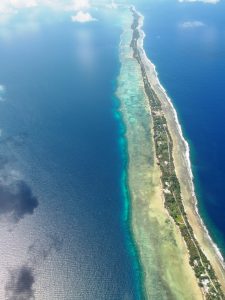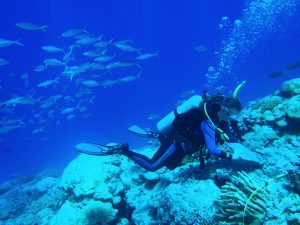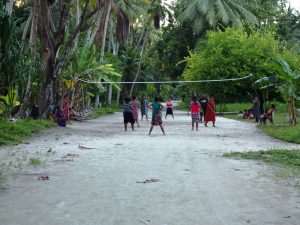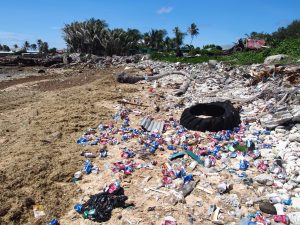 “For God’s sake, do not go to Majuro!”
“For God’s sake, do not go to Majuro!”
It was 2005, and I was on my way to do research in the central Pacific for the first time. The warning was the only ‘advice’ I received about the capital of the Republic of the Marshall Islands, and it came from the only person I had met who had been there: a retired American travelling quickly from country to country for the sole purpose of collecting as many different stamps as possible in his passport. With a trip already scheduled to Kiribati, and spooked a bit by the warning, I shortened the stop in Majuro to just a few days.
It was my loss. Majuro Atoll (top right) is a friendly and fascinating place. Our small team – Sara Cannon from my research group, Diane Thompson from Boston University and soon-to-be PhD student Emma Reed – just completed a research trip to Majuro and its neighbour Arno Atoll. We were there to study climate history and evaluate the effect of climate and local disturbances on the coral reefs.
 Sara, shown at right surveying the coral cover, and Diane have already posted terrific stories and images from the ‘field’ work, including hunting for fossil corals on land, surveying reefs and inadvertently catching tuna in Arno, the reefs off “mount” Majuro and what it is like to live in Majuro. The experience, even the boat rescue (!), was smooth thanks to the grace and hospitality of many local people, including our star supporter Tamara Greenstone-Alefaio, boat captains Ronnie Reimer, Cary Ewarts, and Ben Reimer, Kalena de Brum, Karl Fellenius, and many others.
Sara, shown at right surveying the coral cover, and Diane have already posted terrific stories and images from the ‘field’ work, including hunting for fossil corals on land, surveying reefs and inadvertently catching tuna in Arno, the reefs off “mount” Majuro and what it is like to live in Majuro. The experience, even the boat rescue (!), was smooth thanks to the grace and hospitality of many local people, including our star supporter Tamara Greenstone-Alefaio, boat captains Ronnie Reimer, Cary Ewarts, and Ben Reimer, Kalena de Brum, Karl Fellenius, and many others.
In hindsight, I should have realized that the 2005 advice was bad; it was based on naive first impressions of a foreign place, one that happens to have a garbage problem. If there’s one thing I’ve learned in the past decade of doing research in the Pacific Islands, it is that you need to take the time to understand the context. That, and never take travel tips from someone planning to visit North Korea – one of his “missing 12” countries – by borrowing a French passport and adopting an accent.
 The context: In the old days in the Marshall Islands, people relied on the local resources for food and shelter. Food and human waste could safely go under the coconut tree or below the high tide line. It was all organic, so it would decay, and it was too low in volume to pollute the groundwater or the lagoon with excess nutrients. Homes were built of local thatch and other materials that would also naturally decay; a thatch roof generally needs to be replaced every seven years. For a glimpse of the ‘old days,’ visit one of the outer atolls like Arno where the tidy main street doubles as the volleyball court (right).
The context: In the old days in the Marshall Islands, people relied on the local resources for food and shelter. Food and human waste could safely go under the coconut tree or below the high tide line. It was all organic, so it would decay, and it was too low in volume to pollute the groundwater or the lagoon with excess nutrients. Homes were built of local thatch and other materials that would also naturally decay; a thatch roof generally needs to be replaced every seven years. For a glimpse of the ‘old days,’ visit one of the outer atolls like Arno where the tidy main street doubles as the volleyball court (right).
Then, in a few short years, western packaged goods and building materials became common. The technology – the goods, the materials, the machines – changed far faster than culture could change. It quickly made obsolete the old, reliable waste management techniques, like discarding waste in the bush and below the high tide line, and leaving houses or boats standing until they decay. The household waste builds up – the highest point in Majuro is the landfill. Old, condemned buildings stay standing for years. Metal ships that are no longer seaworthy slowly rust away in the lagoon. Nutrient pollution lowers water quality and promotes algae growth.
Today, thanks to the efforts of people like self-proclaimed “garbologist” Alice Leney, the local practices are slowly evolving to better handle the foreign materials. Alice, an affable Kiwi consultant with a knack for finding suitable local incentives to reduce waste and to recycle, was just in Majuro to work on a new lead-acid battery recycling system for the region. As Diane Thompson mentions in her post, Alice’s mid-2000s Kaoki Mange (“Return the Rubbish”) bottle and can program transformed the streets and beaches of South Tarawa which once looked like the aftermath of a frat party.
 It is understandable how a foreigner who spends only a few days in a remote yet “urban” atoll like Majuro or Tarawa, the capital of Kiribati, might leave with an unfair negative impression. Short-term visitors expect some idyllic island civilization awaiting the apocalypse (of sea-level rise). But if they stroll the side roads and urban shorelines, they find a seemingly post-apocalyptic mix of decaying buildings, abandoned machines and vehicles, rusting shipwrecks, and garbage-strewn beaches like the one in the image at right.
It is understandable how a foreigner who spends only a few days in a remote yet “urban” atoll like Majuro or Tarawa, the capital of Kiribati, might leave with an unfair negative impression. Short-term visitors expect some idyllic island civilization awaiting the apocalypse (of sea-level rise). But if they stroll the side roads and urban shorelines, they find a seemingly post-apocalyptic mix of decaying buildings, abandoned machines and vehicles, rusting shipwrecks, and garbage-strewn beaches like the one in the image at right.
I was certainly guilty of making quick judgements on my first visits to Majuro and its more crowded Kiribati kin of Tarawa. Far too much is lost in translation during short visits to foreign countries. Journalists and researchers who want to understand how climate change and globalization are affecting remote islands need to take time and need to go back for the less glamorous return visits. That lesson is what inspired my piece in Scientific American last year:
Popular culture, from old, fictionalized tales of European beachcombers to the kitsch of the local tiki bar, has perpetuated a stereotype of idyllic islands inhabited by unsophisticated thatch villages. Visiting for just one week with the explicit purpose of documenting the impacts of sea-level rise triggers a cross-cultural positive feedback loop… A North American or European traveling to Kiribati may as well be stepping through a wormhole into another universe.
Next: Part II of the Marshall Islands dispatches – on sea-level rise.
